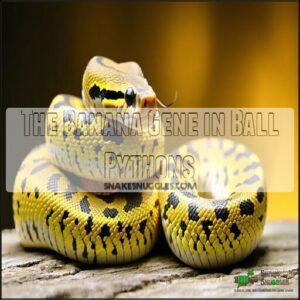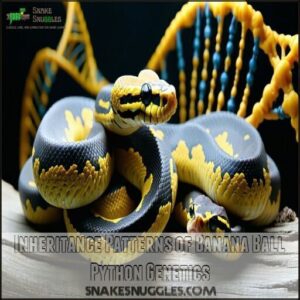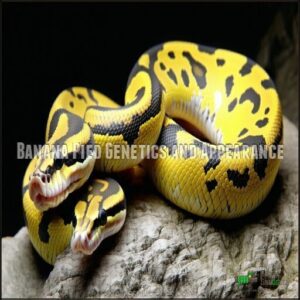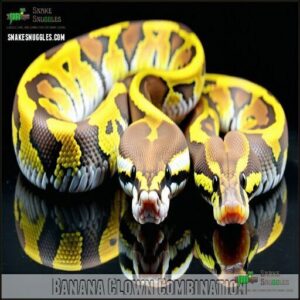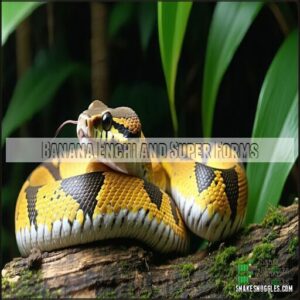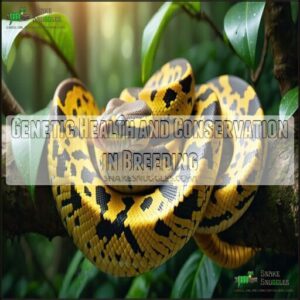This site is supported by our readers. We may earn a commission, at no cost to you, if you purchase through links.

The banana gene sits on the X chromosome, which means inheritance patterns differ depending on the parent’s sex.
Males can be “male makers” or “female makers,” influencing the sex of banana offspring.
It’s a bit like a genetic coin toss, but with rules!
When two bananas breed, you might get a super banana, which showcases even more vibrant colors.
Their golden yellows and lavender tones make them a favorite among breeders and enthusiasts.
Curious how these genetics shape your breeding outcomes?
The patterns might surprise you!
Table Of Contents
- Key Takeaways
- The Banana Gene in Ball Pythons
- Inheritance Patterns of Banana Ball Python Genetics
- Breeding Strategies for Banana Ball Pythons
- Popular Banana Ball Python Morph Combinations
- Genetic Health and Conservation in Breeding
- Frequently Asked Questions (FAQs)
- Do ball pythons have banana genes?
- What is a banana ball python?
- How do ball pythons pass on genetics?
- Are banana ball pythons dominant?
- Are banana ball pythons rare?
- Are ball pythons genetic?
- What makes a banana ball python?
- Is banana a dominant gene in ball pythons?
- Is a banana ball python albino?
- Are coral glow and banana the same?
- Conclusion
Key Takeaways
- The banana gene is a sex-linked, co-dominant trait located on the X chromosome, creating unique inheritance patterns based on the parent’s genetics.
- Male banana ball pythons can be "male makers" or "female makers," influencing the sex ratio of offspring.
- Super Bananas, created by pairing two bananas, have intensified colors and clean patterns, consistently passing banana traits to their offspring.
- Breeders can predict offspring ratios effectively by understanding the banana gene’s inheritance patterns and the difference between co-dominant and sex-linked traits.
The Banana Gene in Ball Pythons
The banana gene in ball pythons is a co-dominant trait located on the X chromosome, giving it a unique role in determining inheritance.
The banana gene creates vibrant yellows and black speckles, making these ball pythons truly mesmerizing genetic masterpieces.
This fascinating gene creates the vibrant yellow colors and black speckles that make these snakes so visually striking.
Genetic Location on X Chromosome
Ever wondered why banana ball pythons look so unique? It’s down to an X-linked trait tied to their sex chromosomes.
Here’s how it breaks down:
- The banana gene is usually found on the X chromosome.
- Occasionally, it jumps to the Y chromosome, spicing up inheritance patterns.
- Females (XX) can carry double banana doses, enhancing certain traits.
- Males (XY) typically hold one banana gene, shaping their striking patterns.
This sex-linked gene also explains why specific pairings create “male-maker” or “female-maker” genetics—a perfect mix of beauty and biology.
Their vibrant colors are due to co-dominant traits.
Co-dominant Trait Characteristics
The banana gene is a shining example of how codominant genes work, creating unique patterns and colors through shared genetic traits.
In banana ball pythons, this single gene leads to amazing visual expression, combining vibrant yellows, subtle purples, and spotting variation.
Its codominant trait nature means no single gene dominates, allowing diverse appearances to emerge.
Over time, you’ll notice fading coloration and even pattern amplification, making each snake’s genetic traits uniquely intriguing.
Super Banana Form
Breeding Super Bananas opens a window into the fascinating world of genetics. These snakes are the result of a codominant Banana gene, and their appearance is truly remarkable. Super Bananas boast faded patterns and a soft, cream-colored background, setting them apart from regular Banana ball pythons.
You’ll also notice the distinct absence of spotting, a key trait when identifying Super Bananas. Since they’re homozygous for the Banana gene, their offspring always inherit vibrant Banana traits.
- **Consistently produce Banana offspring.
- **Unique faded patterns and clean looks.
- Perfect for **studying codominant gene inheritance.
- Highly sought after by breeders.
- Offer reliable, predictable genetic outcomes.
Visual Appearance and Coloration
The visual appearance of a banana ball python is simply dazzling. Their heads often sport light tanned-orange tones, sometimes with quirky asymmetrical spots.
Vivid yellow hues dominate their bodies, blending beautifully with purple undertones that may shift subtly under different lighting.
Here’s a quick visual breakdown:
| Feature | Description | Notable Trait |
|---|---|---|
| Head Coloration | Tanned orange with faded tones | Asymmetrical spots |
| Belly Pattern | Clean yellow center, bold edges | Sharp contrast |
| Spotting Patterns | Random black freckles | Unique to individuals |
As they mature, color fading impacts both yellow and lavender tones. The Super Banana form amplifies this magic with off-white hues and smoother contrasts. Truly mesmerizing!
Inheritance Patterns of Banana Ball Python Genetics
When breeding banana ball pythons, inheritance isn’t as simple as passing a gene from parent to offspring.
The banana trait is sex-linked, meaning its expression depends on whether the gene is carried on an X or Y chromosome, which is a crucial factor in determining the inheritance pattern.
Sex-linked Inheritance
In the context of banana ball python genetics, the sex-linked gene brings a fascinating twist.
Unlike most inheritance patterns, this trait is tied to sex chromosomes.
Specifically, the banana gene sits on the X Chromosome, creating unique inheritance patterns based on whether the parent is a “Male Maker” or “Female Maker.”
- A Male Maker passes the gene through the Y Chromosome, producing mostly male Banana offspring.
- A Female Maker transfers the gene via the X Chromosome, resulting in mostly female Banana offspring.
Female ball pythons (XX) carry double X Chromosomes, equally passing the trait.
Male pythons (XY) rely on gene placement for offspring sex distribution.
Breeders initially noted a predominantly female Banana offspring bias.
This X-linked trait truly makes inheritance patterns remarkable, showcasing the unique characteristics of banana ball pythons and their genetic makeup.
Female Maker Vs Male Maker
The genetic magic of banana ball pythons lies in their X Chromosome and Y Chromosome, defining whether they’re "male makers" or "female makers."
A male maker passes the banana gene almost exclusively to male offspring, influencing the sex ratio remarkably.
In contrast, female makers produce mainly female bananas.
This unique sex determination method shapes breeding outcomes.
Understanding these inheritance patterns lets you predict traits and use genetic tools effectively.
It’s like crafting a genetic roadmap for your next clutch of bananas!
Offspring Ratios in Banana Breeding
Want to unravel the secrets behind banana ball python genetics? Their inheritance patterns are as fascinating as their spots.
With male/female makers, offspring ratios are driven by the gene’s sex-linked location. Breeding a Banana with a normal ball python gives predictable genetic outcomes:
- 50% Banana babies with vibrant yellow hues.
- 50% normal offspring for variation in your clutch.
Pairing two Bananas introduces exciting possibilities:
- 50% Banana babies keep those eye-catching yellows.
- 25% Super Banana outcomes, intensifying patterns and colors.
- 25% normal-looking babies for diversity.
These sex-linked ratios highlight the banana gene’s reliability, making predicting offspring both straightforward and, let’s admit, downright fascinating.
Exceptions to Typical Inheritance Patterns
Banana ball python genetics don’t always follow predictable rules.
Thanks to factors like mosaicism, chimerism, and mutations, inheritance patterns can throw surprises.
For example, some male maker bananas inexplicably produce females, defying their usual X-linked trait.
Environmental factors and epigenetics may also influence these rare occurrences.
These quirks in the sex-linked gene keep breeders guessing, proving nature doesn’t always play by the book.
Super Banana Breeding Outcomes
Breeding Super Bananas reveals fascinating insights into banana ball python genetics and helps in predicting offspring traits.
Here’s the breakdown:
- Breeding two Super Bananas guarantees 100% Super Banana offspring with intensified morph expression.
- Pairing a Super Banana with a normal python produces all Banana offspring.
- Breeding two regular Bananas results in 25% Super Banana, 50% Banana, and 25% normal offspring ratios.
Careful genetic testing guarantees healthy breeding outcomes and avoids genetic defects, which is crucial for predicting offspring traits and ensuring healthy breeding outcomes with intensified morph expression.
Breeding Strategies for Banana Ball Pythons
When breeding banana ball pythons, you’ll need to understand how their unique sex-linked, co-dominant genetics influence offspring outcomes.
Effective pairings, like banana-to-non-banana or super banana strategies, help you control traits while maintaining genetic health.
Banana to Non-Banana Pairings
Pairing a banana ball python with a normal results in fascinating inheritance patterns. Expect a 50/50 split: half the babies proudly display those dazzling banana morph traits, while the others quietly carry the gene.
To explore different colors, consider ball python morphs. Curious about the odds? Check out the table below:
| Outcome | Visual Offspring | Genetic Probability |
|---|---|---|
| Banana Morph | Bright yellow patterns | 50% |
| Normal Appearance | No banana traits visible | 50% |
This pairing reveals morph potential without surprises!
Banana to Banana Breeding Outcomes
Pairing two banana ball pythons gives you a fascinating mix of offspring.
Expect 50% with the classic banana look, 25% stunning Super Bananas with amplified spotting traits and intensified colors, and 25% non-Banana hatchlings.
These inheritance patterns showcase the magic of snake genetics, helping you refine breeding pair selection and predict visual traits for the next generation.
Breeders often explore banana python genetics to enhance their understanding.
Super Banana Breeding Considerations
Super banana ball pythons boast stunning visual traits, but there’s more to breeding them than meets the eye.
Their pale yellow tones, free of black spots, make them highly desirable. However, maintaining strong bloodlines means putting in the extra effort with sound breeding strategies.
To succeed, prioritize these factors:
- Super Visual Traits: Color brilliance fades as they age, so track patterns across generations.
- Ethical Breeding Concerns: Always prioritize their health over aesthetics.
- Genetic Testing Necessity: Test pairings to guarantee desirable traits and minimize health risks.
- Predicting Super Outcomes: Keep a detailed record of pairings and offspring data.
Many breeders also find it helpful to research specialized product offerings to enhance their breeding setups. Smart breeding guarantees your super bananas stay healthy and visually stunning!
Producing Female Maker and Male Maker Lines
Breeding banana ball pythons involves understanding the banana gene’s unique sex-linked nature.
Using smart Maker Line Selection lets you control sex ratios efficiently. Male makers pass the trait to nearly all male offspring, while female makers balance ratios, producing both male and female Bananas.
Here’s a quick comparison:
| Trait | Male Maker | Female Maker |
|---|---|---|
| Chromosome | Y-linked | X-linked |
| Offspring | Mostly male | Even split |
| Predictability | High | High |
| Use | Sex Ratio Control | General Breeding |
| Breeding Focus | Specific Males | Balanced Lines |
Mastering this leads to smarter breeding strategies.
Genetic Diversity and Inbreeding Concerns
Healthy banana ball python genetics require strong lineage tracking and outcrossing strategies.
Without genetic diversity, issues like mutation accumulation and founder effects creep in, threatening your snake’s vitality. Inbreeding can shrink your gene pool, triggering:
- Weak immune systems unable to handle common illnesses
- Hatchlings with lower survival rates and smaller size
- Increased chances of visible genetic defects
- Reduced fertility, making breeding harder over time
Break free from genetic bottlenecks with thoughtful outcrossing strategies. Mix unrelated bloodlines while preserving key traits.
It’s like giving your breeding program a fresh start—your snakes stay vibrant, adaptive, and full of life, ensuring long-term genetic health! Understanding sex chromosomes is essential for predicting offspring ratios.
Popular Banana Ball Python Morph Combinations
When you mix the banana gene with other morphs, you can create an incredible variety of unique patterns and colors.
From vibrant Banana Pieds to striking Albino Banana combinations, these pairings offer endless possibilities for stunning designs.
Banana Pied Genetics and Appearance
The Banana Pied ball python is a jaw-dropping mix of vibrant yellow tones and crisp white splashes, courtesy of its Banana and Pied genetics.
These snakes showcase distinct patterns and spotting variations, making each one uniquely stunning.
The interplay of pattern genetics creates mesmerizing visuals cherished by enthusiasts.
| Trait | Banana Ball Python | Pied Ball Python |
|---|---|---|
| Base Color | Yellow | White and Lilac |
| Unique Markers | Black Spotting | White Patches |
| Pattern Combinations | Spotted-Yellow Blotches | Broken Bands |
Banana Clown Combination
The banana clown morph is a showstopper, combining the banana gene with the recessive clown gene for one dazzling snake.
Its vibrant yellows and oranges glow against bold white pattern outlines, offering stunning clown visuals and unique pattern variations that captivate breeders and enthusiasts alike.
Breeding these morphs poses challenges, but the intensity amplification they bring is worth the effort.
Future combinations with this banana ball python highlight endless possibilities.
- Key Traits: Exceptional color morph and bold patterns.
- Genetic Appeal: Unique pairing of co-dominant and recessive genes.
- Breeding Interest: High-demand morph for collectors.
Banana Enchi and Super Forms
The Enchi gene brings a dazzling twist to the banana ball python’s palette, giving life to brighter yellows, smoother patterns, and perfect highlights.
With Enchi coloration, the yellow and orange tones become more vivid, while dark pigmentation fades to reveal a cleaner appearance. Super Enchi appearances elevate this even further, producing swirls and contrasts that almost feel hand-painted.
Each snake holds unique traits, making them a stunning addition to any collection.
The Enchi morph enhances the side patterns.
- Enchi patterns refine the banana gene’s bold colors.
- Colors become clearer and sharper in super banana and enchi forms.
- Enchi breeding simplifies producing more striking visual differences.
The result? A morph that’s truly unforgettable.
Albino Banana Genetic Interaction
The albino ball python gene paired with the banana ball python genetics creates visual magic. This double recessive blend yields creamy whites and pastel pinks, with the banana masking darker tones.
Albino inheritance alters typical patterning, producing snakes as enchanting as a painted sky. However, breeding challenges arise due to recessive gene complexity.
With careful planning, you can achieve these stunning visual outcomes. Here’s a quick breakdown:
| Trait | Albino Influence | Banana Masking | Visual Outcomes | Breeding Complexity |
|---|---|---|---|---|
| Base color | Creamy white | Enhanced | Soft, harmonious blend | High |
| Pattern retention | Minimal | Moderate | Unique fading effect | Moderate |
| Spotting | Reduced | Suppressed | Subtle | Low |
| Color tones | Pinks, whites | Muted yellows | Dreamy aesthetic | High |
| Key challenge | Gene pairing | Maintenance | Achieving double form | High |
The table outlines the effects of the albino and banana genetics on the ball python’s appearance, including base color, pattern retention, spotting, and color tones. Understanding these factors is crucial for successful breeding and achieving the desired visual outcomes.
Complex Multi-gene Banana Morphs
If you’re fascinated by banana ball python genetics, complex morph combos will blow your mind.
These designer morphs highlight stunning pattern interactions and bold color amplification through creative genetic mutations. Each combo showcases unique gene expression, creating jaw-dropping visuals.
- Banana Spinner: A striking mix of swirling patterns and warm sunset hues.
- Rainbow Banana: Vibrant explosions of color from four combined genes.
- Banana Clown: Bold morph visuals with sharp contrasts and enhanced patterns.
- Super Banana Enchi Piebald: An unbeatable blend of glowing colors and dynamic patterning.
The possibilities for future combinations are endless!
Genetic Health and Conservation in Breeding
You play a pivotal role in ensuring banana ball pythons remain healthy and genetically diverse through responsible breeding.
By prioritizing ethical practices and maintaining variety in captive populations, you help secure their future while minimizing risks like inbreeding.
Maintaining Genetic Diversity in Captive Populations
Think of breeding as assembling nature’s puzzle—each snake’s genetics is a key piece.
To preserve genetic health in captive populations, you’ll need to carefully manage genetic diversity. Avoid bottleneck events and the founder effect by promoting broad gene flow in your breeding program.
Regularly monitor mutation rates and selective pressure to guarantee healthy offspring. Strategic pairings can prevent inbreeding while sustaining diverse inheritance patterns.
By maintaining proper variation, you’re enhancing morph possibilities and also safeguarding the long-term genetic stability of your collection.
Prioritize adequate recovery time for females to regain strength after breeding.
Ethical Considerations in Selective Breeding
Ethical breeding starts with putting animal welfare above morph demand.
Breeding ethics means avoiding genetic defects and hybridization concerns while prioritizing genetic health. Responsible breeders balance creativity with care by maintaining genetic diversity.
- Prioritize healthy pairings that avoid common defects.
- Test for genetic issues before breeding.
- Focus on quality care over producing trendy morphs, which is a key aspect of responsible breeders.
Conservation Implications of Banana Ball Python Genetics
Protecting Banana Ball Pythons isn’t just about their vibrant colors—it’s tied to preserving wild populations and guaranteeing genetic diversity for long-term survival.
Ethical breeding plays a major role in supporting sustainable practices while avoiding inbreeding risks. Careful strategies also contribute to wider conservation efforts, keeping these snakes healthy and thriving.
Here’s how breeders make an impact:
- Preserve genetic diversity: Avoid repetitive pairings to guarantee robust offspring.
- Support conservation efforts: Reduce wild captures by prioritizing captive breeding.
- Adopt ethical breeding practices: Breed responsibly to protect both snakes and ecosystems.
Each choice in breeding ripples outward, influencing not just collected morphs but species health worldwide.
Future Research Directions in Banana Gene Expression
DNA research is unraveling how banana ball python genetics work.
Scientists are focusing on gene mapping and modifier genes to perfect breeding accuracy.
Studies on epigenetic factors and protein interactions could soon control unexpected mutations.
Tools like CRISPR technologies promise healthier snakes by monitoring cellular mechanisms and improving gene expression.
Enhanced genetic testing also makes tracking inheritance patterns easier, helping breeders predict traits.
These discoveries guarantee banana morphs retain their dazzling look without compromising health.
Frequently Asked Questions (FAQs)
Do ball pythons have banana genes?
Some ball pythons do carry the banana gene, which gives them striking yellow patterns and black freckles.
This gene is co-dominant and sex-linked, meaning inheritance and offspring traits depend on parental genetics.
What is a banana ball python?
A banana ball python is a colorful snake morph known for its vibrant yellow blotches, lavender background, and random black freckles.
These striking traits make it a favorite among collectors and reptile enthusiasts.
How do ball pythons pass on genetics?
Around 50% of offspring inherit a specific morph when pairing a morph-carrying ball python with a normal one.
Genetics, including genes on sex chromosomes, decide morphs, making breeding feel like a genetic puzzle-solving adventure!
Are banana ball pythons dominant?
They’re not fully dominant; instead, banana ball pythons carry a codominant gene.
This means a single gene produces their unique look, and pairing two bananas can create a “super banana,” amplifying their vibrant features.
Are banana ball pythons rare?
They’re not exactly rare, but they’re unique!
Banana ball pythons are popular among breeders and enthusiasts due to their striking colors and patterns.
Their availability has increased, making them easier to find than before.
Are ball pythons genetic?
It’s fascinating—every ball python carries a genetic story.
Traits like color, patterns, and even size pass through their DNA.
Breeders use this to create stunning morphs, combining unique genes to produce a world of variety.
What makes a banana ball python?
A banana ball python gets its vibrant yellow and lavender color from a co-dominant, sex-linked gene.
This genetic trait causes unique black freckles and bold color changes as the snake matures.
Is banana a dominant gene in ball pythons?
Think of genetics like a recipe—banana in ball pythons is a co-dominant gene, meaning one copy shows its vibrant colors.
It’s also sex-linked, adding unique twists based on the parent snakes’ chromosomes.
Is a banana ball python albino?
No, a banana ball python isn’t albino, but the confusion’s understandable.
It has vibrant yellow and lavender colors with black spots, unlike true albino pythons, which lack black pigment and have pinkish-red eyes.
Are coral glow and banana the same?
Coral Glow and Banana ball pythons are genetically the same morph, differing only in name.
Some breeders stick with “Coral Glow,” but both terms describe snakes with the same stunning coloration and inheritance patterns.
Conclusion
Think of banana ball python genetics like playing Tetris with chromosomes—it’s a puzzle with fascinating outcomes.
The banana gene’s unique traits, influenced by its location on the X chromosome, create both stunning visuals and intriguing inheritance patterns.
Understanding male makers, female makers, and super banana forms allows you to predict offspring with precision.
Whether you’re captivated by their golden hues or strategic breeding possibilities, diving into these genetics guarantees you’ll never look at snakes the same way again!
- https://onlinelibrary.wiley.com/doi/abs/10.1111/evo.13543
- https://www.sciencedirect.com/science/article/pii/S096098221730711X
- https://www.semanticscholar.org/paper/CHROMOSOME-STRUCTURE-AND-CROSSING-OVER.-Uhl/76e430cd69d4d67797ace147da2d51caa4d413d9
- https://community.morphmarket.com/t/morphpedia-ball-pythons-coral-glow/21600
- https://www.youtube.com/watch?v=VjEiGnMYFdA

